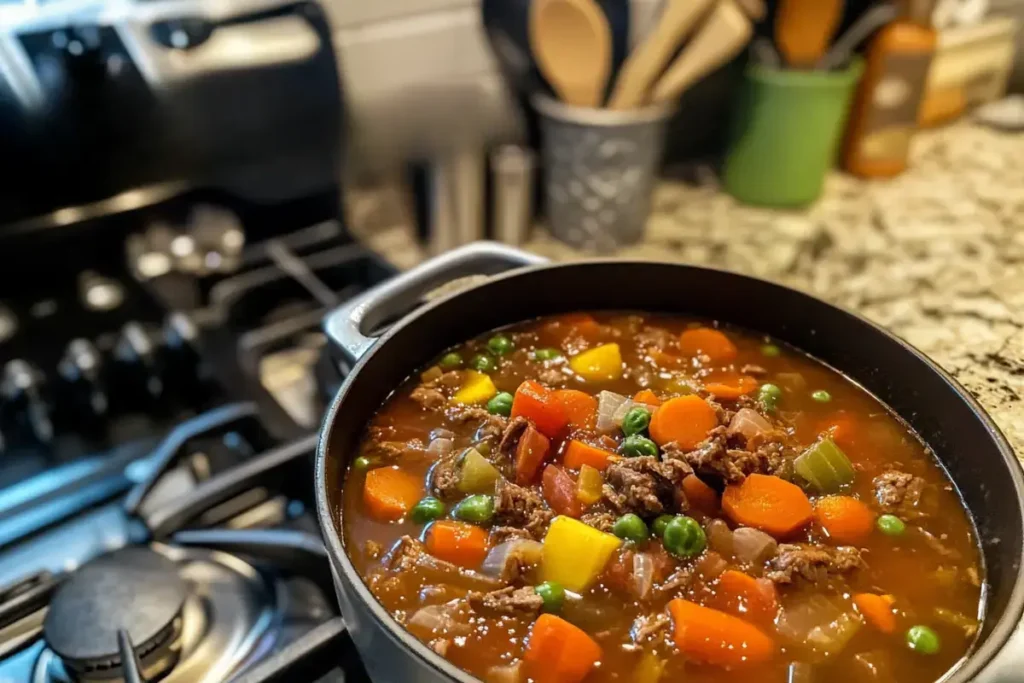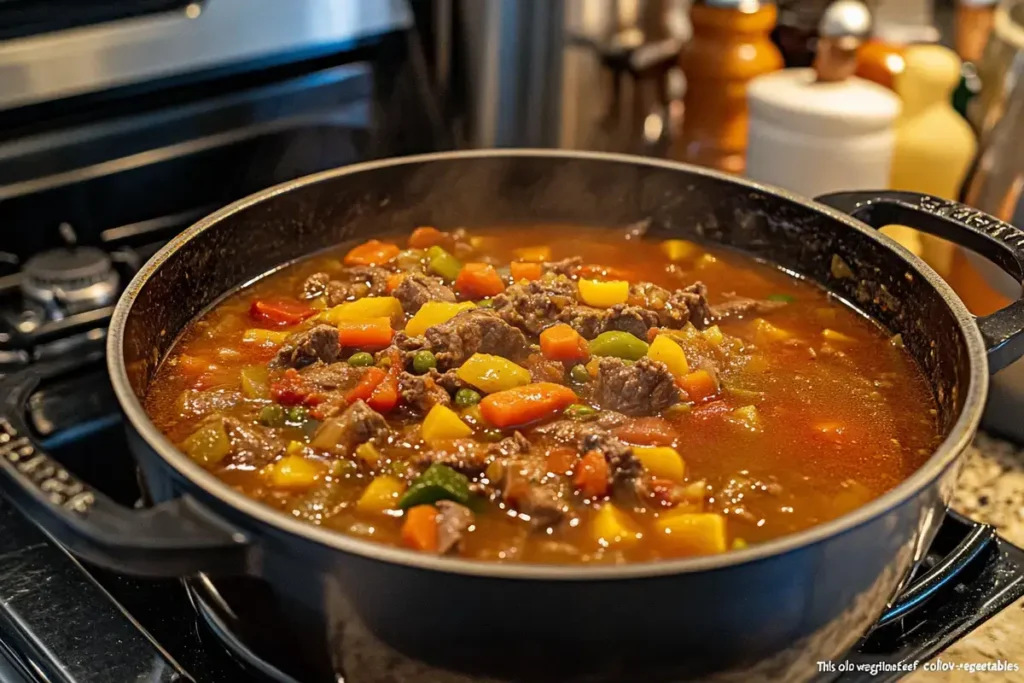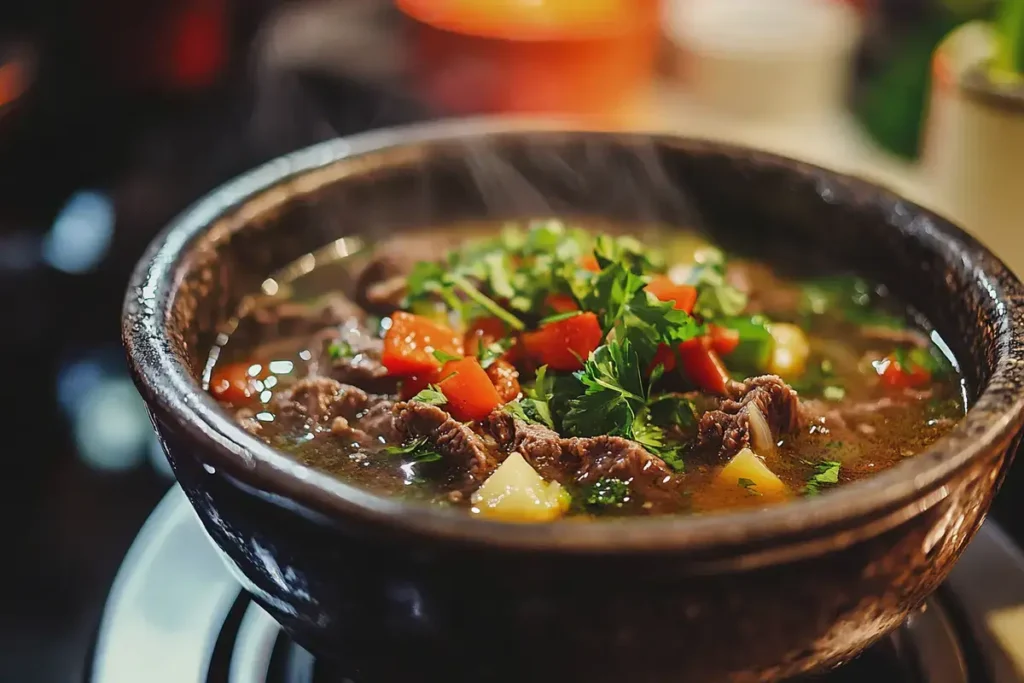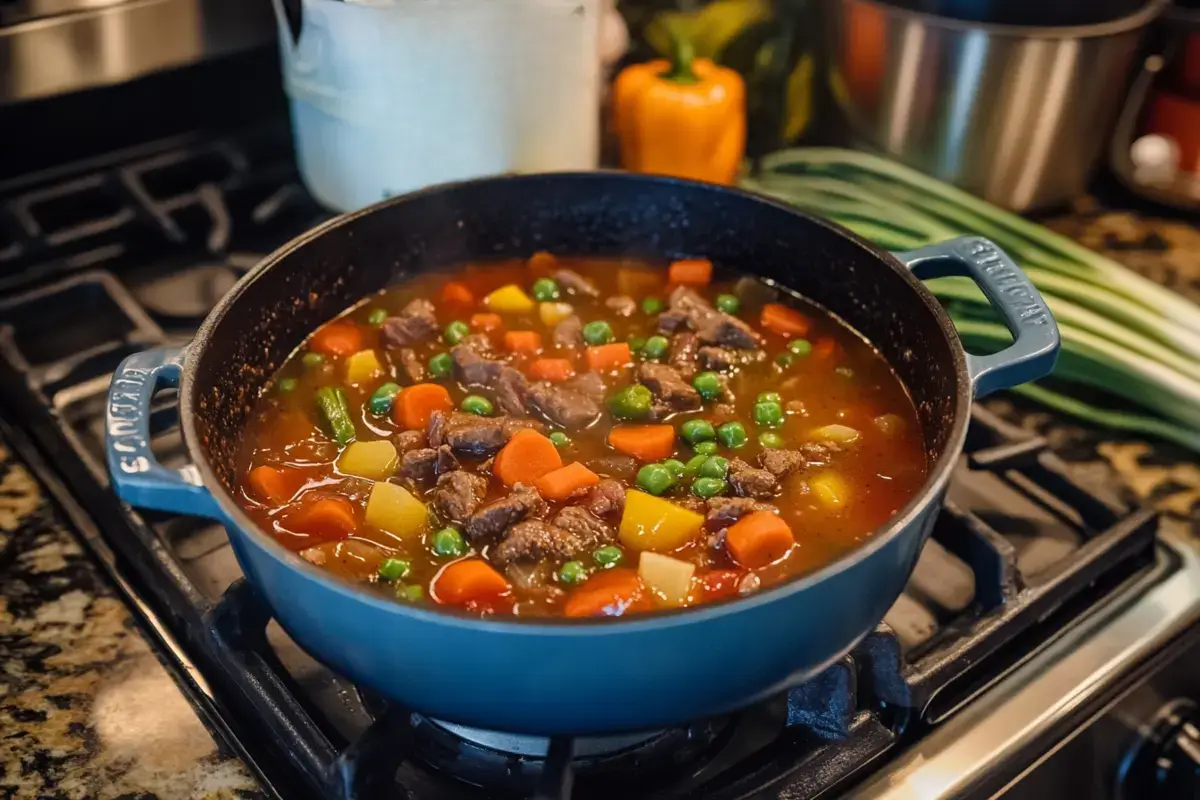Satisfy your craving for homemade goodness with beef, vegetables, and savory broth. Enjoy the warmth of tradition in every spoonful.
Introduction
Few dishes can rival the coziness of an old fashioned vegetable beef soup recipe. The savory fragrance of simmering beef combined with the sweetness of fresh vegetables immediately evokes nostalgia. Indeed, preparing such a soup invites the entire household to gather and anticipate a hearty meal. This article provides a complete guide, ensuring your soup brings both comfort and remarkable flavor to the table.
In the following sections, you will learn about the best beef cuts, the most impactful vegetables, and how to season everything perfectly. Because soup preparation often merges artistry with technique, this article breaks down each step. Consequently, you will master the cooking process and delight in the aromas that fill your kitchen.
Why This Old Fashioned Vegetable Beef Soup Recipe Evokes Comfort?
Soup plays a starring role in many cultural traditions. Historically, people have simmered meats and vegetables to stretch ingredients and keep everyone well-fed. This old fashioned vegetable beef soup recipe remains popular because it balances nutrition and nostalgia. Slow cooking allows the beef to soften, while the vegetables release natural sweetness.
Traditions often shape our love for soup. Many remember a grandparent coaxing flavors from a simmering pot, occasionally stirring and tasting. Over time, the same method passed down, preserving the comfort factor. Consequently, each spoonful reminds us of warmth and shared family moments. This comforting quality endures, making the dish perfect for cold evenings, family dinners, or simple weekend lunches.
Cultural appreciation contributes, too. Different regions have variations of beef-based soups. Comparatively, ours highlights the American approach—carrots, celery, onions, potatoes, and tender chunks of beef in a robust broth. While new-age recipes come and go, this old fashioned vegetable beef soup recipe stands the test of time.
Key Ingredients for a Successful Old Fashioned Vegetable Beef Soup Recipe
Beef Cuts:
Selecting the right cut matters. Chuck roast is an excellent choice because of its marbling and connective tissues that break down over low heat. Stew meat, often a mix of different cuts, also works if it has enough fat content. Some prefer shank for its ability to yield an especially velvety broth. Regardless of your pick, ensure you have chunks about an inch in size. This dimension encourages even cooking and tender, juicy bites.
Vegetable Selections:
A typical old fashioned vegetable beef soup recipe incorporates onions, carrots, and celery, often regarded as the aromatic trio. Potatoes introduce a starchy creaminess. If you desire extra color, green beans or peas can be thrown in. Indeed, fresh produce elevates flavor. However, frozen vegetables remain a practical substitute when you are short on time or off-season.
Herbs, Spices, and Seasoning Fundamentals:
Salt, pepper, thyme, and bay leaves form the core seasoning profile. Bay leaves impart subtle earthy notes, while thyme pairs brilliantly with beef. Rosemary can be used in moderation if you want a more herbaceous twist. Garlic is a must for many cooks. Minced or crushed, garlic deepens the savory aspect when sautéed with onions.
Worcestershire sauce is another ingredient that intensifies flavor. Paprika or chili flakes, meanwhile, can provide a mild zing if you enjoy a hint of heat. Always remember to taste as you go. Because soups develop flavor over time, minor seasoning tweaks might be needed later.
Stock or Broth Choices:
Beef stock brings out the heartiness of the soup, but water or vegetable stock can still create a satisfying result. Some cooks blend beef stock and water to control sodium. If opting for store-bought broth, read labels carefully to avoid excessive salt or additives. High-quality broth enriches the final taste.
Essential Tools and Preparation Techniques
A large, heavy-bottomed stockpot or Dutch oven is ideal. These pots distribute heat uniformly, preventing scorching during extended simmering. Sharp knives ensure even cutting. When vegetables and beef chunks are uniform, they cook at a similar pace.
Mise en place, or prepping everything beforehand, makes the cooking flow seamless. Dice onions, peel carrots, and measure spices in separate bowls. Accordingly, each component is ready at the critical moment you need it. This approach also reduces the risk of overlooking ingredients.

Step-By-Step Process for Making an Old Fashioned Vegetable Beef Soup Recipe That Delights
- Brown the Beef:
Heat a tablespoon or two of oil in the pot over medium-high heat. Pat the beef dry, season with salt and pepper, then brown in batches. Crowding the pot causes steaming, which undermines browning. Once you see a brown crust, transfer the meat to a plate. - Sauté Vegetables:
With the beef set aside, sauté onions and celery in the same pot. Stir to pick up the brown bits, or fond, at the bottom. After a few minutes, toss in carrots. Then add garlic and let it release its fragrance for about a minute. - Deglaze:
Pour in a bit of stock or water to deglaze the pot. Scrape up the fond. This step injects the soup with significant depth. Once combined, return the beef to the pot. - Add Liquids and Herbs:
Now, add the remaining broth. Stir in thyme, bay leaves, and other preferred seasonings. Bring everything to a gentle boil. Reduce the heat, cover the pot, and let it simmer. - Incorporate Potatoes and Additional Vegetables:
After roughly 30 minutes of simmering, add potatoes. If you are including peas or green beans, add them closer to the end to maintain some texture. Keep the lid on, stirring every so often. The goal is tenderness without overcooking. - Taste and Adjust:
Periodically sample the broth. Add salt, pepper, or a dash of Worcestershire sauce as needed. If the liquid reduces too much, pour in extra stock or water. If it tastes thin, simmer uncovered to concentrate flavors. - Finish and Serve:
When the beef is fork-tender and the vegetables are just right, turn off the heat. Remove the bay leaves. Ladle into bowls and garnish with chopped parsley or grated cheese if you wish.
Flavor Enhancement and Seasoning Adjustments
Achieving robust flavor often requires layering. Browning the meat creates the base. Sautéing onions, celery, and carrots in those pan drippings adds aromatic richness. Deglazing lifts even more flavor from the pot’s bottom. The final simmer unifies all these components.
Acidity can balance the richness of beef. Thus, a small splash of vinegar or lemon juice in the last few minutes can brighten the soup. However, add it gradually so you do not disrupt the meal’s comforting balance. Tomato paste is another option if you prefer a light tomato undertone. Sauté the paste briefly before adding more liquid to caramelize its natural sugars.
Umami boosters, such as soy sauce or a bit of miso paste, can also deepen flavor. Use them sparingly. Too much might overshadow the soup’s classic taste. Remember to sample after each addition, ensuring you align with your flavor preference.
Soup Thickness and Consistency Tips
A proper old fashioned vegetable beef soup recipe can be brothy or thick, depending on personal tastes. If you want a thicker consistency, mash some of the potatoes once they cook fully. This natural starch helps the soup become creamier. Another tactic: remove a cup of broth and vegetables, blend them, and pour them back. Flour or cornstarch can thicken as well, but these methods skew the soup toward a stew-like character.
If your soup appears too dense, you can thin it with extra stock or water. Just remember to taste frequently. For some, the ideal texture is a full-bodied broth in which tender beef and vegetables swim, rather than a heavily thickened stew.
Proper Storage and Reheating for an Old Fashioned Vegetable Beef Soup Recipe
Once you complete cooking, allow the soup to cool slightly. Move it to airtight containers, leaving a bit of headspace at the top if freezing. Typically, soup keeps for up to four days in the refrigerator. In the freezer, you can store it for two to three months with minimal loss of quality.
When reheating, a gentle approach is best. Over high heat, you risk breaking down the vegetables into mush. Instead, simmer over medium heat, stirring occasionally. If it thickened overnight, add some water or stock. Many argue soup tastes even better the second day as flavors meld more fully overnight.

Serving Suggestions and Meal Pairings
Pairing your old fashioned vegetable beef soup recipe with crusty bread is a timeless delight. Sourdough or a baguette can soak up the rich broth. Cornbread, on the sweeter side, pairs nicely too. Alternatively, serve a fresh green salad with a vinaigrette to lighten the meal.
If entertaining guests, consider topping the soup with fresh herbs or shredded cheese. A sprinkling of parsley brightens the bowl visually. Chopped chives add mild onion notes. For a bit of indulgence, stir in a swirl of cream or a pat of butter. Small garnishes can elevate the meal’s presentation, making it more festive.
Nutritional Considerations and Dietary Options
Beef is a significant source of protein, iron, and B vitamins. Meanwhile, vegetables provide essential vitamins, minerals, and fiber. Together, they form a balanced bowl. If you prefer a lower-fat version, trim any visible fat from the beef. Skimming the top of the soup while it simmers can also help reduce fat content.
For low-carb variations, omit or reduce potatoes. Cauliflower florets can substitute. For a lower-sodium approach, select salt-free or low-sodium broth and rely on herbs for flavor. If you need gluten-free soup, verify that your stock and any thickening agents do not contain hidden gluten sources.
Common Mistakes and Helpful Tips
- Overcrowding the Pot During Browning: Give meat space to form a lovely crust. Otherwise, you lose flavor from caramelization.
- Forgetting to Deglaze: The fond at the bottom of the pot holds concentrated taste. Deglazing with stock or wine ensures you capture it.
- Adding All Vegetables Too Early: Timings differ. Potatoes might need longer, while peas or green beans require less time.
- Over-Seasoning Early: Soup’s flavor intensifies as it simmers. Start moderately and adjust closer to the end.
- Rushing the Simmer: True depth emerges over extended, gentle cooking. Resist hurrying.
Beyond these pitfalls, you can personalize the soup with finishing touches. A few drops of hot sauce amplify heat for those who like it spicy. A grating of Parmesan can introduce nutty notes. Essentially, once you master the foundation, you can tweak nuances to suit your cravings.

Frequently Asked Questions (FAQ)
1. What can I add to my vegetable soup to give it more flavor?
Concentrate on a strong aromatic base. Sauté onions, garlic, and celery in oil or butter before adding liquid. Additionally, fresh herbs, tomato paste, or a dash of Worcestershire sauce can infuse greater depth. A small pinch of chili flakes or cayenne also adds a lively twist.
2. How to add depth of flavor to vegetable soup?
Roasting or browning your vegetables first increases their natural sweetness. Deglazing the cooking pot lifts caramelized bits. Also, incorporate a robust broth and umami-rich elements like mushrooms or miso. Basically, layering flavors at each step can create a more compelling taste.
3. How to add more flavor to beef soup?
Start with high-quality meat. Sear the beef thoroughly to form a brown crust, which intensifies the broth. Next, use aromatic veggies, bay leaves, and thyme. If you enjoy bolder notes, Worcestershire sauce or even a splash of red wine can deepen the profile. Let it simmer patiently to bring all flavors into harmony.
4. What is the most flavorful beef for soup?
Chuck roast is commonly praised for its marbling and tenderness when cooked slowly. Shank offers excellent richness from its collagen. Stew meat can work if it has enough marbling. Generally, cuts with connective tissue, such as chuck, yield a silkier broth and juicy bites of meat.

